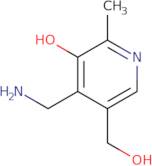4-(Aminomethyl)-5-(hydroxymethyl)-2-methylpyridin-3-ol
CAS: 85-87-0
Ref. 3D-AAA08587
| 1g | Descontinuado | ||
| 2g | Descontinuado | ||
| 50mg | Descontinuado | ||
| 100mg | Descontinuado | ||
| 250mg | Descontinuado | ||
| 500mg | Descontinuado | ||
| 2500mg | Descontinuado |
Informação sobre produto
- 2-Methyl-3-hydroxy-4-aminomethyl-5-hydroxymethylpyridine
- 3-Pyridinemethanol, 4-(aminomethyl)-5-hydroxy-6-methyl-
- 4-(Aminomethyl)-3-hydroxy-5-(hydroxymethyl)-2-methylpyridine
- 4-(Aminomethyl)-5-(Hydroxymethyl)-2-Methylpyridin-3-Ol
- 4-(Aminomethyl)-5-hydroxy-6-methyl-3-pyridinemethanol
- Piridoxamina
- Pyridoxamin
- Pyridoxylamine
4-(Aminomethyl)-5-(hydroxymethyl)-2-methylpyridin-3-ol is a metabolite of the nonsteroidal anti-inflammatory drug (NSAID) piroxicam. It has been shown to inhibit the production of nitric oxide by inactivating a mitochondrial enzyme called nitrate reductase. Nitric oxide has an important role in the pathogenic mechanism of various inflammatory diseases, such as rheumatoid arthritis and gastritis. 4-(Aminomethyl)-5-(hydroxymethyl)-2-methylpyridin-3-ol also inhibits protein synthesis in bacteria and other organisms, including humans. This inhibition may be due to its ability to bind to bacterial ribosomes and interfere with protein synthesis. This drug is also able to inhibit polymerase chain reaction (PCR) products from DNA templates that have been modified with pyridoxamine, which can be used as a diagnostic





